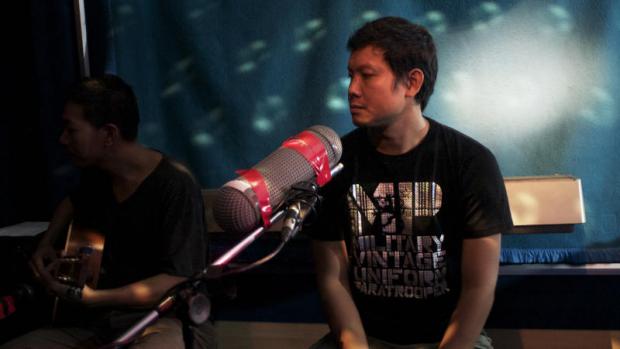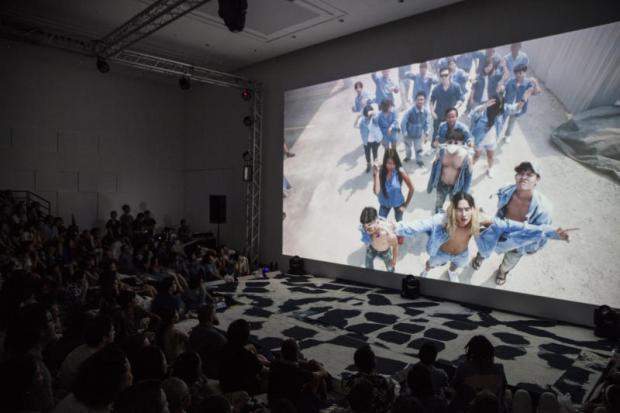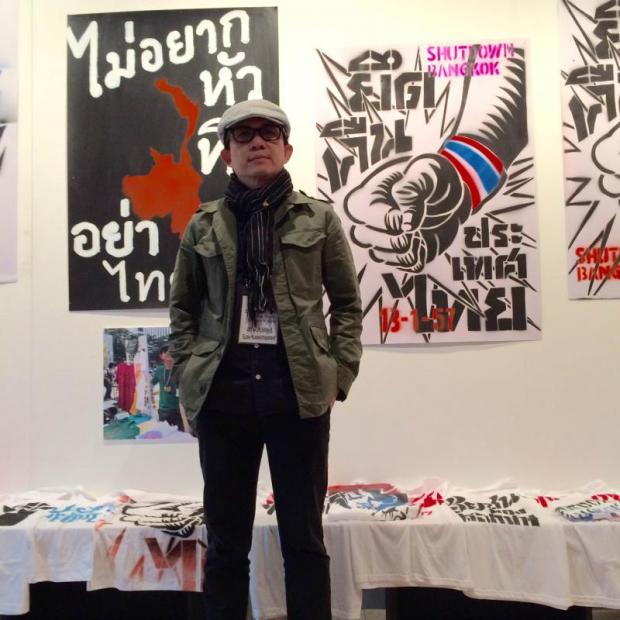It has been a busy year for the Thai art scene, with well-known artists taking turns treating Bangkok viewers to their latest works, new galleries welcomed and old ones closing down, and politics remaining deeply embedded in artistic expression.
For instance, the year began with Chiang Mai's MAIIAM Contemporary Art Museum and Apichatpong Weerasethakul's fascinating retrospective, then internationally-renowned Korakrit Arunanondchai's first shows in Bangkok spanning two venues -- the Jim Thompson Art Center then Bangkok CityCity Gallery.
The more-than-one-venue trend continues after that, with Manit Sriwanichapoom's latest photography and video show "Fear" at H Gallery, Tang Contemporary Art and Kathmandu Photo Gallery, while Udomsak Krisanamis's latest exhibition, "Paint It Black", ran concurrently with his conceptual retrospective at Chiang Mai University (CMU) Art Center.
It has been a year of good but also bad news. While the art scene has continued to expand from Bangkok to the provinces, Thavibu Gallery closed down and Chulalongkorn University's the Art Center soon will follow suit. But most importantly, it has been a year when the political atmosphere has served to define both the art shows and the dialogues of artists, curators and viewers.
We look back at the art scene in 2016 and its outstanding aspects.
Hello and Goodbye
The year began with the hype surrounding the opening of Chiang Mai's MAIIAM Contemporary Art Museum and its inaugural show "The Serenity Of Madness", renowned filmmaker and artist Apichatpong Weerasethakul's first-ever retrospective in his home country. Now 2016 is almost over, but the buzz hasn't quite faded. The launch of the museum is crucial on so many levels. First of all, the museum is now a must-visit destination for anyone visiting the northern city. More importantly, it serves as a much-needed institution that collects important pieces of Thai contemporary artists.
Independent curator Chol Janepraphaphan said that this could possibly explain why we have seen large-scale works that seem to be, consciously or otherwise, engaging directly with potential collectors, such as MAIIAM, rather than galleries or viewers as usual.
Here in Bangkok, the biggest source of art-world buzz could be N22, a commune of galleries in Narathiwat Ratchanakharin 22 that has just seen yet another addition: Angkrit Gallery, a second venue by artist Angkrit Ajchariyasophon after Chiang Rai. Gallery VER has had quite an active year, coming up with one strong show after another, from Mit Jai Inn, Udomsak Krisanamis, Sutthirat Supaparinya and Thasnai Sethaseree. Meanwhile, Tentacles next door is still going strong with its attempt at creating a sustainable model of a space run by an artist collective.
Another exciting addition to the Bangkok art scene is Nova Contemporary, and its recent exhibition "Under The Same Sky" by Tada Hengsapkul and Chai Siris has established the gallery as a space committed to meaningful social and political dialogue. Last month, viewers were thrilled by the presence of world-renowned photographer Steve McCurry, best known for his 1984 Afghan Girl National Geographic cover, and who was here for his solo exhibition "A Lifetime Of Work" at House of Lucie, the capital's latest art space by Lucie Awards founder Hossein Farmani.
For curator Brian Curtin, Bangkok Citycity Gallery, Gallery VER, Nova Contemporary and MAIIAM "continued with predictable exhibitions that highlighted what we already know". He added that TARS Gallery, last year's exciting new addition to the scene, has lately not been fulfilling its early promise of curatorial innovation, and that Jam remains the best art space in Bangkok, dynamic and unpredictable.
The biggest losses to the art scene are of course the closing down of Thavibu Gallery and Chulalongkorn University's The Art Center, which will be gone permanently early next year. After 18 years, the Thavibu Gallery now continues as Thavibu Art Advisory, a company that works on a project basis with international collectors, museums, art foundations and auction houses focusing on Thai, Vietnamese and Myanmar art.
As for The Art Center, it is just a shame -- even an embarrassment, I dare say -- on Chulalongkorn University's part that it fails to see the importance of having a cultural institution where, over the past two decades, political and social dialogue has been vigorously pursued through the visual arts.
Abstract and Political
Abstract art seems right for Thailand's current political climate when direct expression is hushed up. Gallery VER alone has presented three such exhibitions, starting with Mit Jai Inn's crazed storms of colours on massive canvases, Udomsak Krisanamis' mesmerising circles of paint, and Thasnai Sethaseree's hidden layers of political commentary. Angkrit Gallery at N22 also opened with an abstract show, "Rebirth Of The Cool", by Thaiwijit Puengkasemsomboon. Over in Chiang Mai, Gallery Seescape saw two abstract shows, by Morakot Ketklao and Kade Javanalikhikara. Atikom Mukdaprakorn of Chiang Mai Art Conversation doesn't think this profusion of movement is a coincidence -- that it has to do with current sociopolitics.
Thasnai's paintings in his show "What You Don't See Will Hurt You" are interesting in the way they seem abstract but actually are not, and that speaks for many other exhibitions this year. Months into the third year following the 2014 coup, works that directly engage the authoritarian rule are becoming scarce compared to in the first two years. Common are the shows that merely speak about the fact that things cannot be spoken about. Thasnai goes full-on at various episodes of Thai dark history just to censor himself through his art practice. At Bridge Art Space, due to the passing of King Bhumibol Adulyadej, artist Sina Wittayawiroj cancelled his previously planned show and came up with another show entitled "This Show Is Cancelled", to document the cancellation of his show.
Decentralisation
That Chiang Mai is a second capital of the Thai art scene isn't exactly a 2016 thing. Since the early 1990s, the northern city has been home to a significant art movement such as the Chiang Mai Social Installation (CMSI), but this is especially more palpable with the launch of the MAIIAM Contemporary Art Museum.
Strengthening that are various other art-related bodies that have popped up in recent years like TCDC Chiang Mai, Chiang Mai Art Conversation and Asian Culture Station.
2016 has been particularly exciting because of what has also been going on outside of Bangkok and Chiang Mai. For the second edition of Ratchaburi's community-based "Art Normal", the city known for its earthenware jars and floating markets has seen more visitors who had come for over 70 artworks installed at venues throughout town.
Over in Songkhla, there was a launch of the About Art Related Activities' art and preservation project by Klaomard Yipintsoi and photographer Nopadon Kaosam-ang, the couple who founded About Studio/About Cafe, a fabled art space that was the driving force behind Bangkok's art scene from the mid-1990s to the mid-2000s. The highlight of the affair is a three-storey museum dedicated to works by Misiem Yipintsoi, a legendary Thai painter and sculptor. Chiang Mai-based artist Navin Rawanchaikul also joined forces, and his usual art of lively old-school movie posters and music videos has managed to bring out the life and colour of the community through his first-hand research and interactions with the people.
Ideological Row
A major sensation of the year is sadly not how good and exciting a show or an emerging artist is but a dispute of ideological divide.
To commemorate the 1980 Gwangju Uprising against the military dictatorship, the Gwangju Museum of Art in South Korea this year presented the exhibition "The Truth_To Turn It Over" by Thai artist Sutee Kunavichayanont. This sparked an outburst of criticism from a section of Thai artists and scholars, later identifying themselves as Cultural Activists for Democracy (CAD), because one of Sutee's four series selected for the show entitled "Thai Uprising" was done in support of the People's Democratic Reform Committee (PDRC), which took to the streets to protest the Yingluck Shinawatra government following the blanket amnesty bill proposal.
One camp says that just because the series was done in support of the PDRC doesn't mean that Sutee was supporting the coup. The other, however, insists that such argument is absurd. This divide in the art scene is not new, but never before has it been so visible and internationalised. Open letters have been sent to the Gwangju Museum of Art, and advocates from both ends have made themselves, perhaps for the first time, visible by signing these letters.
The Gwangju Museum of Art later publicly apologised for not researching well enough for the exhibition, and agreed to display the letters from both sides along with the artwork. The museum has also invited representatives from CAD for a public talk, and all the discussions and letters will be documented in the museum's archive. It seems the row is over but only in appearance. These days, we never seem to see the two groups at the same exhibition. The Thai art scene is ever so small, and that's rather sad.

Still from Apichatpong Weerasethakul's video work Sakda (Rousseau). Photo courtesy of Apichatpong Weerasethakul

Mit Jai Inn's Junta Monochrome series as part of exhibition 'Wett'. Gallery Ver

Korakrit's Painting With History In A Room Filled With People With Funny Names 3 at Bangkok CityCity Gallery. Supphariksh Phattrasitthichoke

Sutee Kunavichayanont and his works in the exhibition 'The Truth_To Turn It Over' at the Gwangju Museum of Art. Photo courtesy of Sutee Kunavichayanont

